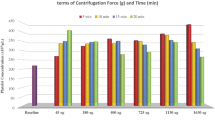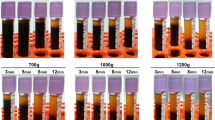Summary
Thrombocyte yields up to 1,4×1011 per litre of separated whole blood were obtained using centrifuge speed up to 2000 RPM. With increasing speed, higher platelet concentrations in the thrombocyte zone were accompanied by a progressive decline of thrombocyte counts in the plasma zone, whereas the thrombocyte contamination in the erythrocyte zone remained unchanged. Taking into account both high extraction efficiency and good preservation of platelet function as measured by Breddin's spreading test, optimal conditions for thrombophoresis with the Aminco Celltrifuge® have been obtained at 1600 RPM. Since repeated separation of the donor's blood resulted in a rising number of platelets with impaired spreading capacity, the total blood flow should be limited to the blood volume of the donor.
Zusammenfassung
Bei Zentrifugendrehzahlen zwischen 1600 und 2000 UPM lassen sich in der Celltrifuge® pro Liter separierten Blutes durchschnittlich 1,0–1,4×1011 Thrombozyten isolieren, was einer Extraktionseffizienz von über 60% entspricht. Dabei geht die Thrombozytenanreicherung in der Thrombozytenzone mit einer starken Thrombozytenverarmung im Plasma einher, während die Thrombozytenkontamination in der Erythrozytenzone über den untersuchten Drehzahlbereich konstant bleibt. Gemessen an der Ausbreitungsfähigkeit der Thrombozyten wird das beste Verhältnis zwischen Ausbeute und Erhaltung der Thrombozytenfunktion bei einer Drehzahl von 1600 UPM erreicht. Da mehrfacher Durchlauf des Spenderblutvolumens durch die Zentrifuge ebenso wie weitere Erhöhung der Zentrifugendrehzahl zu einem Anstieg des Anteils nicht ausbreitungsfähiger Thrombozyten führt, sollte die Durchlaufmenge auf das einfache Blutvolumen beschränkt bleiben.
Similar content being viewed by others
Literatur
Adam, W., Heimpel, H., Diehl, K., Hiemeyer, V.: Die Bedeutung der Isolierungsmethode für Ausbeute und Überlebenszeit der Blutplättchen bei der Thrombozytentransfusion. Therapiewoche47, 2125–2127 (1968)
American Instrument Company. Instruction 943-1, Catalog No. 6900 A, December 1973
Borberg, H., Hellriegel, K.P., Gross, R.: Erfahrungen zur klinischen Anwendung der Celltrifuge. Verh. Dtsch. Ges. Inn. Med.80, 1499–1502 (1974)
Borberg, H., Cremerius, R.: Der Haemonetics — Blutzellsepartor Modell 30. Wissensch. Informationen, Fresenius-Stiftung, Heft 2, 123–126 (1975)
Breddin, K.: Die Thrombozytenfunktion bei hämorrhagischen Diathesen, Thrombosen und Gefäßkrankheiten. Thromb. Diath. haemorrh., Suppl. 27. Stuttgart: F. K. Schattauer 1968
Breddin, K.: Die Behandlung der Thrombozytopenie unter besonderer Berücksichtigung der Thrombozytentransfusion. Therapiewoche47, 2120–2124 (1968)
Diehl, K., Hiemeyer, V., Adam, W., Heimpel, H.: In vitro-Untersuchungen zur Plättchenfunktion bei der Isolierung von Thrombozyten zur Herstellung von Thrombozytenkonserven. Therapiewoche47, 2127–2129 (1968)
Evenkamp, G., Eckert, G., Schmidt, C.G.: Fortschritte in der Frage des Thrombozytenersatzes bei aplastischen Thrombopenien. Med. Welt23, 1385–1386 (1972)
Evenkamp, G., Eckert, G., Hornung, Ch., Schmidt, C.G.: Kontinuierliche extrakorporale Thrombophorese mit dem IBM-Blutzellseparator. Klin. Wschr.50, 574–579 (1972)
Freireich, E.J.: Leucocyte Collection and Transfusion: A Historical Perspective. In: Leucocytes, Separation, Collection and Transfusion (eds. Goldman, J.M., Lowenthal, R.M.), p. 27–36. London-New York-San Francisco: Academic Press 1975
Graw, R.G., Herzog, G.P., Eisel, R.J., Perry, S.: Leucocyte and Platelet Collection from Normal Donors with the Continuous Flow Blood Cell Separator. Transfusion11, 94–101 (1971)
Jones, A.L.: Continuous-flow Blood Cell Separation. Transfusion8, 94–103 (1968)
Judson, G., Jones, A., Kellog, R., Buckner, D., Eisel, R., Perry, S., Greenough, W.: Closed Continuous-flow Centrifuge. Nature217, 816–818 (1968)
Lani, K., Pfisterer, H., Ruppelt, W., Bolland, H., Stich, W.: Studies on the Separation of Granulocytes for Transfusion from normal Persons by the IBM Cell Separator. Blut12, 35–38 (1970)
Lani, K., Pfisterer, H., Ruppelt, W., Bolland, H., Stich, W.: Leukound Thrombophorese bei Gesunden mit dem NCI-IBM Blutzellseparator. Klin. Wschr.49, 327–332 (1971)
Reuter, H., Linker, H.: Die Gewinnung von Plättchenkonzentraten für Transfusion und Konservierung. Forschungsergebnisse der Transfusionsmedizin und Immunhaematologie2 715–724 (1974)
Wissenschaftliche Tabellen, Documenta Geigy, 7. Aufl., S. 553. Basel: J. R. Geigy 1968
Wysk, J., Schüttler, W., Eckert, G., Stangel, W., Deicher, H.: Optimierte Bedingungen der Thrombozytenseparation im Zellseparator (Aminco). Forschungsergebnisse der Transfusionsmedizin & Immunhaematologie3, 319–322 (1976)
Author information
Authors and Affiliations
Additional information
Mit Unterstützung der Stiftung Volkswagenwerk, Az. 112858.
Rights and permissions
About this article
Cite this article
Wysk, J., Schüttler, W., Stangel, W. et al. Thrombophorese I. Blut 35, 377–386 (1977). https://doi.org/10.1007/BF00996624
Received:
Revised:
Issue Date:
DOI: https://doi.org/10.1007/BF00996624




